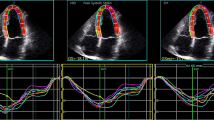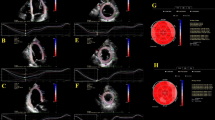Abstract
This study sought to investigate the prognostic potential of layer-specific global longitudinal strain (GLS) in predicting cardiac events among non-ST-segment elevated acute coronary syndrome (NSTE-ACS) patients with preserved LVEF. In this prospective study, we enrolled 160 consecutive NSTE-ACS patients with preserved LVEF (≥ 50%) who underwent successful percutaneous coronary intervention (PCI). Transthoracic two-dimensional echocardiography examinations were performed within 48 h of admission (before PCI). Cardiac events were defined as all-cause death, re-infarction, and hospitalization for heart failure. During a median follow-up of 30.2 months, 23 patients (14.4%) developed cardiac events. GLS for all three myocardial layers were reduced in patients with adverse outcome (all P < 0.001). Yet GLSendo (area under curves = 0.85) and GLSmid (area under curves = 0.83) showed relatively higher predictive power than GLSepi when identifying patients with cardiac events. The best cut-off value of GLSendo was − 20.8%, with a diagnostic sensitivity and specificity of 87% and 71% respectively. A significant increase in the risk of cardiac events development was shown among patients with impaired layer GLS (log-rank test, P < 0.001). In conclusion, NSTE-ACS patients with preserved LVEF, layer GLS assessed before PCI all had good abilities to predict cardiac events, which might provide more prognostic information against conventional echocardiographic risk factors.




Similar content being viewed by others
References
Solomon SD, Anavekar N, Skali H et al (2005) Influence of ejection fraction on cardiovascular outcomes in a broad spectrum of heart failure patients. Circulation 112:3738–3744
Møller JE, Hillis GS, Oh JK et al (2006) Wall motion score index and ejection fraction for risk stratification after acute myocardial infarction. Am Heart J 151:419–425
Vartdal T, Brunvand H, Pettersen E et al (2007) Early prediction of infarct size by strain Doppler echocardiography after coronary reperfusion. J Am Coll Cardiol 49:1715–1721
Mitchell C, Rahko PS, Blauwet LA et al (2019) Guidelines for performing a comprehensive transthoracic echocardiographic examination in adults: recommendations from the American Society of Echocardiography. J Am Soc Echocardiogr 32:1–64
Eek C, Grenne B, Brunvand H et al (2010) Strain echocardiography and wall motion score index predicts final infarct size in patients with non-ST-segment-elevation myocardial infarction. Circ Cardiovasc Img 3:187–194
Ersboll M, Valeur N, Mogensen UM et al (2013) Prediction of all-cause mortality and heart failure admissions from global left ventricular longitudinal strain in patients with acute myocardial infarction and preserved left ventricular ejection fraction. J Am Coll Cardiol 61:2365–2373
Antoni ML, Mollema SA, Delgado V et al (2010) Prognostic importance of strain and strain rate after acute myocardial infarction. Eur Heart J 31:1640–1647
Sengeløv M, Jørgensen PG, Jensen JS et al (2015) Global longitudinal strain is a superior predictor of all-cause mortality in heart failure with reduced ejection fraction. JACC Cardiovasc Imaging 8:1351–1359
Stanton T, Leano R, Marwick TH (2009) Prediction of all-cause mortality from global longitudinal speckle strain: comparison with ejection fraction and wall motion scoring. Circ Cardiovasc Imaging 2:356–364
Hwang IC, Chon GY, Yoon YE et al (2018) Association between global longitudinal strain and cardiovascular events in patients with left bundle branch block assessed using two-dimensional speckle-tracking echocardiography. J Am Soc Echocardiogr 31:52–36
Sabbah HN, Marzilli M, Stein PD (1981) The relative role of subendocardium and subepicardium in left ventricular mechanics. Am J Physiol 240:H920–H926
Buckberg G, Hoffman JI, Mahajan A et al (2008) Cardiac mechanics revisited: the relationship of cardiac architecture to ventricular function. Circulation 118:2571–2587
Sebastian IS, Kristina HH, Wasim Z et al (2013) Layer-specific quantification of myocardial deformation by strain echocardiography may reveal significant CAD in patients with non-ST elevation acute coronary syndrome. JACC Cardiovasc Imaging 6:535–544
Liu C, Li J, Ren M et al (2016) Multilayer longitudinal strain at rest may help to predict significant stenosis of the left anterior descending coronary artery in patients with suspected non-ST-elevation acute coronary syndrome. Int J Cardiovasc Imaging 32:1675–1685
Nishi T, Funabashi N, Ozawa K et al (2019) Regional layer-specific longitudinal peak systolic strain using exercise stress two-dimensional speckle-tracking echocardiography for the detection of functionally significant coronary artery disease. Heart Vessels 34:1394–1403
Skaarup KG, Iversen A, Jørgensen PG et al (2018) Association between layer-specific global longitudinal strain and adverse outcomes following acute coronary syndrome. Eur Heart J Cardiovasc Imaging 19:1334–1342
Hamada S, Schroeder J, Hoffmann R et al (2016) Prediction of outcomes in patients with chronic ischemic cardiomyopathy by layer-specific strain echocardiography: a proof of concept. J Am Soc Echocardiogr 29:412–420
Levine GN, Bates ER, Blankenship JC et al (2011) ACCF/AHA/SCAI Guideline for percutaneous coronary intervention. A report of the American College of Cardiology Foundation/American Heart Association Task Force on Practice Guidelines and the Society for Cardiovascular Angiography and Interventions. J Am Coll Cardiol 58:e44–e122
Amsterdam EA, Wenger NK, Brindis RG et al (2014) 2014 AHA/ACC Guideline for the management of patients with non-ST-elevation acute coronary syndromes. J Am Coll Cardiol 64:2713–2714
DeLong ER, DeLong DM, Clarke-Pearson DL (1988) Comparing the areas under two or more correlated receiver operating characteristic curves: a nonparametric approach. Biometrics 44:837–845
Park YH, Kang SJ, Song JK et al (2008) Prognostic value of longitudinal strain after primary reperfusion therapy in patients with anterior-wall acute myocardial infarction. J Am Soc Echocardiogr 21:262–267
Munk K, Andersen NH, Terkelsen CJ et al (2012) Global left ventricular longitudinal systolic strain for early risk assessment in patients with acute myocardial infarction treated with primary percutaneous intervention. J Am Soc Echocardiogr 25:644–651
Mollema SA, Delgado V, Bertini M et al (2010) Viability assessment with global left ventricular longitudinal strain predicts recovery of left ventricular function after acute myocardial infarction. Circ Cardiovasc Img 3:15–23
Woo JS, Kim WS, Yu TK et al (2011) Prognostic value of serial global longitudinal strain measured by two-dimensional speckle tracking echocardiography in patients with ST-segment elevation myocardial infarction. Am J Cardiol 108:340–347
Luis SA, Chan J, Pellikka PA (2019) Echocardiographic assessment of left ventricular systolic function: an overview of contemporary techniques, including speckle-tracking echocardiography. Mayo Clin Proc 94:125–138
Shah AM, Claggett B, Sweitzer NK et al (2015) Prognostic importance of impaired systolic function in heart failure with preserved ejection fraction and the impact of spironolactone. Circulation 132:402–414
Curtis JP, Sokol SI, Wang Y et al (2003) The association of left ventricular ejection fraction, mortality, and cause of death in stable outpatients with heart failure. J Am Coll Cardiol 42:736–742
Funding
The study was funded by the National Natural Science Foundation of China (Grant No. 81571681, No. 81671762, No. 81701707, No. 81701720).
Author information
Authors and Affiliations
Contributions
Concept/design: J-wT and CL; Data analysis/interpretation: S-qJ, JL, Z-zW, X-pL, G-qD, Y-jL, B-bZ, Z-gD; Drafting article: CL; Critical revision of article: CL; Approval of article: J-wT; Statistics, CL, JL, Z-gD; Funding secured by S-qJ, Z-zW, X-pL, G-qD, Y-jL; Data collection: S-qJ, JL, Z-zW, X-pL, G-qD, Y-jL.
Corresponding author
Additional information
Publisher's Note
Springer Nature remains neutral with regard to jurisdictional claims in published maps and institutional affiliations.
Rights and permissions
About this article
Cite this article
Liu, C., Jiang, Sq., Li, J. et al. Prognostic potential of layer-specific global longitudinal strain in patients with non-ST-segment elevated acute coronary syndrome and preserved left ventricular ejection fraction. Int J Cardiovasc Imaging 37, 1301–1309 (2021). https://doi.org/10.1007/s10554-020-02119-6
Received:
Accepted:
Published:
Issue Date:
DOI: https://doi.org/10.1007/s10554-020-02119-6




